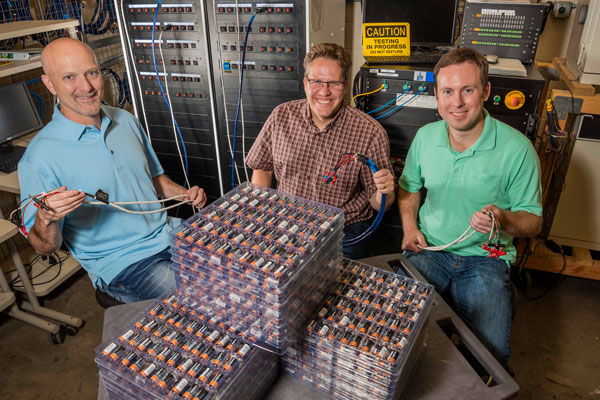Entrepreneur assistance program that helped launch company turns 25

Joe Beck and Eric Branson’s business grew so fast it took them a year just to find time to put up a sign.
“It’s since gone way beyond our expectations,” said Beck, president and CEO of Albuquerque-based Advanced Manufactured Power Solutions, or AMPS. The custom manufacturing company builds battery packs, cables and other small components of larger machines.
Sandia’s Entrepreneurial Separation to Transfer Technology program helped Beck and Branson, both former employees, launch their small business. The 3-year-old company reached a significant growth milestone recently with its first out-of-state contract, a project for NASA’s Jet Propulsion Laboratory in Pasadena, California.
For 25 years, ESTT has promoted the creation of innovative small businesses by allowing staff to leave the Labs with a guaranteed job waiting if they return within two years. Spinoff tech companies such as AMPS create high-paying jobs that help stimulate local economies.
ESTT has helped 162 employees bring business ideas into their respective communities since its inception. Of those, 74 started new companies and 88 expanded companies, primarily in New Mexico. Historically, 67% of Sandia participants chose not to return to Sandia. The average annual salary of jobs recently created is $106,000.
Sandia inspires industry-spanning ventures
Companies formed and grown by Sandia employees span the tech industry. Conductor Analysis Technologies Inc., the first company formed through ESTT (in 1994), tests printed circuit boards. WaveFront Sciences Inc. produced the first commercial product to take eye measurements that could be used to program LASIK corrective surgery. Diagnostic and digital health company Sandstone Diagnostics Inc. created the first Food and Drug Administration cleared at-home male fertility test.
“Many successful companies have their origins at Sandia, and each one exemplifies the entrepreneurial spirit found here. We’re proud to see our former colleagues continuing to better society from the private sector,” said Jackie Kerby Moore, Sandia’s manager of technology and economic development. “And in the case of AMPS, they continue to support Sandia’s national security mission.”
Sandia’s entrepreneurial program offers employees meetings with Sandia licensing, legal and technical experts, as well as the local business community. Because Beck and Branson anticipated they would be bidding for contracts from Sandia, these meetings helped them establish practices and policies to protect the company from potentially disqualifying conflicts of interest.
Although no policy restricts Sandia employees from leaving their jobs to start up their own businesses, doing so under the auspices of ESTT gives employees a valuable safety net, encouraging them to pursue sometimes risky ventures with the knowledge that they can return. The program also facilitates licensing when employees want to use Sandia technology outside the Labs.
Entrepreneurs who return are gladly welcomed back. They bring freshly honed business skills that strengthen Sandia.
Vendors lift national security on paper wings
AMPS is now a Sandia supplier, and like other suppliers, has found a niche in national security work by developing specialized, highly detailed documentation, much to the delight of Sandia’s Brian Perdue.
Brian, a power source engineer, has an unusual appreciation for paperwork. He revels in reports, valuing the record of how a part was built as much as the part itself. To him, a good paper trail is how he determines the quality of a part and is instrumental in uncovering the source of a problem, should one arise. That information, he says, means everything when working in national security, where margins for error are incredibly slim.
Sandia’s primary mission is ensuring the U.S. nuclear arsenal is safe, secure and reliable. The nation’s nuclear weapons must always work when commanded by the U.S. president and never detonate otherwise.
“It’s as if Sandia built a car. We would need to know we could park it for up to 30 years and that it will run perfectly when we turn the ignition,” said Brian, who has collaborated with AMPS on multiple projects.
When a vendor like AMPS is hired, for example, to weld and solder together common AA batteries into a single battery pack, Sandia requires extensive paperwork to document exactly how they did it and the materials used, which might detail everything from the weights of the batteries down to the name of the mine that produced the metals in the solder.
Branson, AMPS vice president and chief technology officer, says his company has tested thousands of commercial batteries for barely perceptible variations, so they can report that their products are built precisely to Sandia design specifications.
These details might seem excessive, but the slightest variations in processes or materials — the kinds one might see from one source to another — are enough to make a part fail Sandia’s rigid requirements, Brian said.
Have a business idea?
Contact Genaro Montoya (gmontoy@sandia.gov) for more information about the Entrepreneurial Separation to Transfer Technology program.